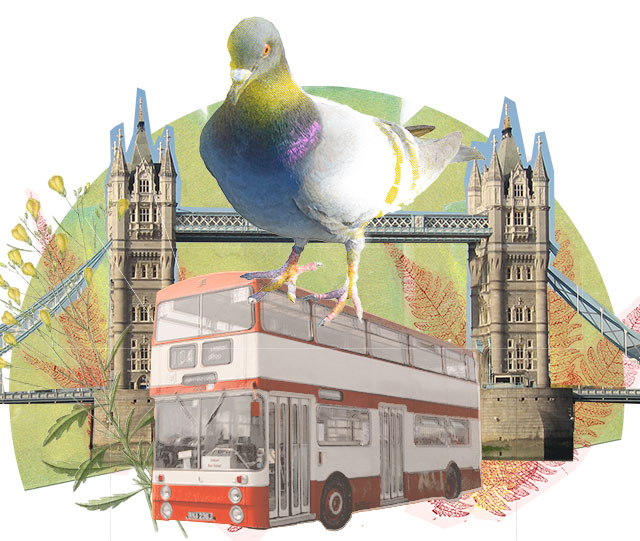Humans have been an urban species for at least 7,000 years, since the days of Jericho and Eridu. Ancient cities were relatively small: walled enclosures surrounded by fields and pastures. Today, of course, our cities are huge conglomerations of asphalt, concrete, metal, brick, and glass sometimes sprawling to the horizon. Greater Tokyo, for example, covers about 12,000 square miles. More than half of humanity now lives in cities, and most of those reside in mega-cities containing millions of people; by 2050 that number is expected to reach 70 percent.
 photo illustration Lilli Keinaenen
photo illustration Lilli Keinaenen
We usually think of cities as uniquely human environs, the crucibles of our culture and the breeding ground of our technologies. But we’re not alone in our homes. Other creatures have found ways to live among us. The wild has managed to sneak into even the most constructed landscapes. My own city, London, is a perfect example.
During the last two millennia, London has transformed from a few farmers to a massive urban area of 8 million people. All those people in one place create a unique ecosystem, an island of concrete with its own microclimate (up to 5°C warmer than the surrounding countryside on summer nights) and specific ecological niches for some species to thrive. Look closely, and you can witness the push and pull between humans and other species acted out in the microcosm of London’s streets, gardens, and waterways.
Let’s start with flora. Many of the plants that dominate the scenery here aren’t native to the area. Two thousand years ago, London rocket arrived with the Romans, then hung on as a rarity, proliferating in long, dry summers like the one before the Great Fire of London in 1666. Today it is proliferating again, likely due in part to climate change; variation in the color of rocket flowers suggests that new arrivals or subspecies are augmenting the existing population. Another nonnative, the tree-of-heaven, is planted throughout London with a frequency that rivals the famously pollution-resistant London plane. Brought in from China, the tree-of-heaven was previously well-behaved, but during the last 20 years it has begun to throw up seedling after seedling, developing the invasive behavior it shows in warmer climes.
Insects, too, have adapted to our built environments, often helped along by our incessant human commerce. The black vine weevil was likely another Roman import; other vine weevils such as the southern green shield bug and the unpopular harlequin ladybird have all arrived since 2000. Experts blame changes in the horticultural industry – lower trade barriers mean many more seedlings coming in from Southern European nurseries.
Six years ago, curators at London’s Natural History Museum discovered a new insect species in their own garden. Entomologists figure that the rice-sized, red and black insect is a version of an insect common on the European continent, Arocatus roeseli, which has evolved to live on London’s plane trees. “‘I don’t expect to find a new species in the gardens of a museum,” the museum’s collections manager told the Daily Mail. “Deep inside a tropical rainforest yes, but not in central London.”
Human behavior also affects the fortunes of native plants and animals. Wall ferns have been recorded in London since 1771, but they nearly disappeared as coal fumes neutralized the lime mortar they grow on. After the Clean Air Act of 1956 banned coal burning in London, the ferns gradually re-established themselves; during the last 20 years their population has exploded. Long-absent lichens have also returned thanks to decreases in sulfur emissions. Cleaner air also means that bats and insectivore birds are doing better as insect life increases.
Some birds and animals have discovered that city living might be easier and more convenient than scraping out an existence in the wild. Foxes, finding the countryside precarious, have moved into London, where half-eaten burgers in bins are plentiful and predators are few. Cormorants find the pickings richer in the increasingly clean Thames than in the fished-out North Sea, and are now a regular sight on dilapidated river pilings. Common terns are another beneficiary of the push for cleaner water. Some now-common birds are newcomers. Beginning with a single flock in West London, ring-necked parakeets have moved into parks across London. No one knows quite how they came to be here; one theory blames Jimi Hendrix for releasing a pair in Carnaby Street in the 1960s.
The fast life of the big city has also changed birds’ songs. Research has found birds changing the pitch, speed, and volume of their calls to make themselves heard against the urban roar. Slower songs may echo less, and so be more distinct. Birds are especially adept at making the most of the different spaces available in urban areas; nests on traffic lights are not uncommon. And despite extensive anti-pigeon netting, every bridge in the city seems to have its complement of pigeons perching and nesting. Birds are also resourceful about using our trash to build their homes; my local coots use plastic scraps in their nests.
Just like cities themselves, wildlife reinvents itself, doing whatever it must to survive and thrive. I find this a hopeful thought. Life persists, even in those places that we have made seemingly uninhabitable for other creatures. We have built our cities for ourselves, but they don’t belong to us alone.
We don’t have a paywall because, as a nonprofit publication, our mission is to inform, educate and inspire action to protect our living world. Which is why we rely on readers like you for support. If you believe in the work we do, please consider making a tax-deductible year-end donation to our Green Journalism Fund.
DonateGet four issues of the magazine at the discounted rate of $20.